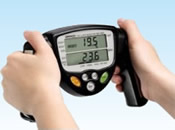Other Methods
Body Mass Index (BMI)
BMI is the most commonly used method by medical professionals to monitor obesity. BMI does not take into consideration the fat content of your body), as it is based on the individual's weight and height. Instead, it assumes that body mass is closely associated with body fat which has been shown to be a tenuous assumption scientifically. For example, an anorexic person would have a perfect BMI, but in danger, because of a very high fat content. On the other hand, a fit muscular athlete would have a significantly high BMI and considered obese, but would have a very low body fat content.
Skinfold
 Skinfold thickness is measured using a caliper at specific locations on the body. The thickness measurement are the applied to formulas which translate the numbers into an estimate of a person's percentage of body fat according to their age and gender.
Skinfold thickness is measured using a caliper at specific locations on the body. The thickness measurement are the applied to formulas which translate the numbers into an estimate of a person's percentage of body fat according to their age and gender.
Bioelectrical Impedance Analysis (BIA)
 Introduced in the mid-eighties, BIA is a quick, easy and safe method to measure body fat and lean tissue. BIA works on a simple principle of water conduction as water is a great conductor of electricity. A large proportion of the human body is made up of water which is not stored uniformly throughout the body. Lean muscle contains a lot of water, while fat tissue has practically none. Therefore, when a small current is passed through the body by the device, it passes easily through muscle, but in fat, it meets resistance. The resistance is measured and the data, along with other details such as your height, age, weight, and gender, is used establish the percentage of body fat.
Introduced in the mid-eighties, BIA is a quick, easy and safe method to measure body fat and lean tissue. BIA works on a simple principle of water conduction as water is a great conductor of electricity. A large proportion of the human body is made up of water which is not stored uniformly throughout the body. Lean muscle contains a lot of water, while fat tissue has practically none. Therefore, when a small current is passed through the body by the device, it passes easily through muscle, but in fat, it meets resistance. The resistance is measured and the data, along with other details such as your height, age, weight, and gender, is used establish the percentage of body fat.
Underwater Weighing (UWW)
Initially, the body is weighed in air and then submerged and weighed under water. Air remaining in the lungs is also measured and an approximation is made of the air in the digestive tract. An estimate of the total body density is calculated using the difference in weight of the body in air and water as well as the volume of water displaced by the body.
Air Displacement Plethysmography (ADP)

This technique adapts the same principles as Underwater Weighing, but uses air instead of water. Individuals are seated in a sealed compartment (BodPod) that measures their body volume through the displacement of air. The body volume is combined with the body weight to establish the body density. An estimate of the percentage of body fat and lean body mass is determined using formulas. It should be noted that claustrophobia is in issue.
Dual-Energy X-ray Absorptiometry (DXA)
 DXA is currently the most widely used method to measure bone mineral density. During the session, an individual lies on an examining table and two x-ray beams with different energy levels scan the body. It takes about 20 minutes to do a body scan of which the bone mass and soft tissue mass are determined. Using these results, the percentage of body fat can be calculated.
DXA is currently the most widely used method to measure bone mineral density. During the session, an individual lies on an examining table and two x-ray beams with different energy levels scan the body. It takes about 20 minutes to do a body scan of which the bone mass and soft tissue mass are determined. Using these results, the percentage of body fat can be calculated.
Magnetic Resonance Imaging (MRI)
 Similar to DXA, an individual is placed on an examining table and then gently glided into position inside the MRI machine. When the machine is turned on, a strong magnetic field is created and radio frequecies are directed at the individual's body. Because there is no radiation involved it can perform a total body scan for maximal accuracy and fat distribution. The machine can separate visceral fat from subcutaneous fat, muscle from organs and determine bone densities.
Similar to DXA, an individual is placed on an examining table and then gently glided into position inside the MRI machine. When the machine is turned on, a strong magnetic field is created and radio frequecies are directed at the individual's body. Because there is no radiation involved it can perform a total body scan for maximal accuracy and fat distribution. The machine can separate visceral fat from subcutaneous fat, muscle from organs and determine bone densities.
FT-NIR Spectroscopy Versus Other Methods
| Method | Accuracy | Ease of Use | Accessibilty | Portability | Affordability |
|---|---|---|---|---|---|
| FT-NIR Spectroscopy | |||||
| Skinfold | |||||
| BIA | |||||
| UWW | |||||
| ADP (BodPod) | |||||
| DXA | |||||
| MRI |
FT-NIR Spectroscopy is a simple, fast, reliable, non-invasive, cost-effective and accurate tool to measure body fat content.